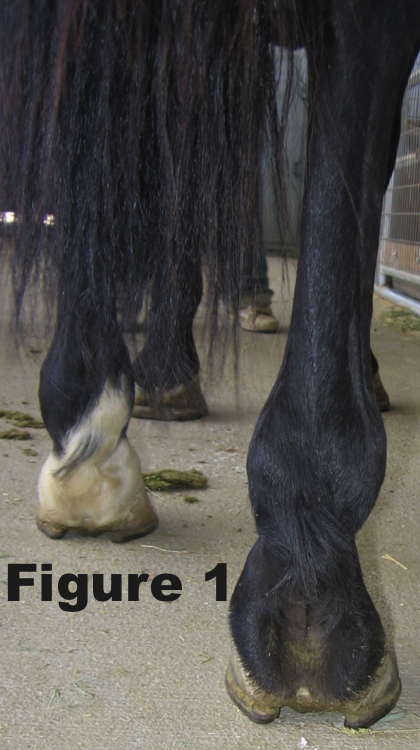In the Delta Mustad Hoofcare Center Lunchtime Panel discussion on shoeing the hinds at the International Hoof-Care Summit, Kirk Adkins says his career has changed. The former chief farrier at the University of California-Davis still is referred to on cases. One in particular case of a cutting horse game him some pause and provides a good example of how perplexing the hinds can be at times, especially for the performance horse.
“As you can see (Figure 1) it’s very distorted, very twisted,” he notes. “As he moved, the foot came up and it went through some strange gyrations when he was going away. So they ended up getting some X-rays (Figure 2). What we have a rotational deviation of the coffin bone. It twisted medially, rotated medially. I had pretty good alignment of the sole to the ground, and the footfall was fairly good. But he has a wedged P2.
 |
 |
 |
“This horse went immediately lame when he got into cutting horse training. Because all they do is trot down, stop on their hind end, and turn and go back the other direction and that’s all they do – back and forth, back and forth.”
Adkins says the distortions like these create tremendous stress on the horse and so the farrier must take steps to figure out an appropriate shoeing solution. In this particular case, he points back to Figure 1 and the good parallelism under the fetlock, yet how but it bends around. He notes the vertical depth on the medial side of the P3 and this extreme distortion to the outside of the coffin bone.
“So there’s no way this foot is going to look good or work good,” he says. “And so he eventually got cut from the team. Sometimes the owners need to take the X-rays and look at them before we get them, because they’d save a lot of money.”
Figure 3 shows how Adkins shod the horse.
“I just took a slight flare to the inside with the crease,” he says. “All of my horses get a little bit of a rocker motion. I start back behind the first two nail holes and begin to do that.”
One problem Adkins says occurs among cutting horses And one of them, the other problem that they have is locking patellas. He finds that adding a little extended heel and begin a roller motion can help.
“Nothing fancy on the shoe — it’s just simple stuff to get this horse going,” he says. “My basic premise on handling these hind limb issues is I try to do is find the plane of the coffin bone and level that up. The capsule distortions, we can float some heels and do some other things on it. But really when you get something that’s not going sound and it’s just persistent, even though it looks like it might be alright but just sort of out of wonk. You need to see what kind of alignment you have in the joint surfaces.







Post a comment
Report Abusive Comment